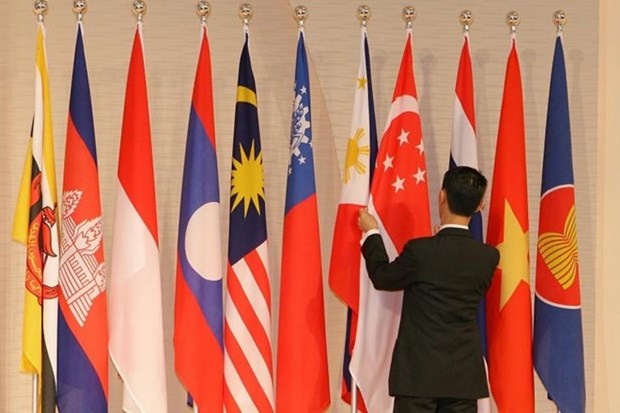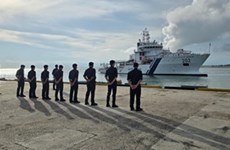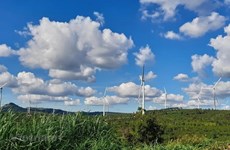Three pillars of to-be-formed ASEAN Community
The ASEAN Community will officially take shape on December 31 this year with three pillars: the Political-Security Community, the Economic Community and the Socio-Cultural Community.
 The ASEAN flag (first, right) and the flags of the bloc's member nations (Photo: straitstimes.com)
The ASEAN flag (first, right) and the flags of the bloc's member nations (Photo: straitstimes.com)Hanoi (VNA) – The ASEAN Community will officially take shape on December 31 this year with three pillars: the Political-Security Community, the Economic Community and the Socio-Cultural Community.
This will be a milestone in the bloc’s history as the regional peoples connect, share interests and develop on a new path.
The ASEAN Community’s overall goal is to build the Association of Southeast Asian Nations (ASEAN) into an extensive and more binding inter-governmental cooperation organisation on the legal basis of the ASEAN Charter.
The ASEAN Economic Community (AEC), the most important pillar, is considered a precondition for the realisation of the other two pillars. It aims to create a single market and production base characterised by free flow of goods, services, investment, capital and skilled labour, thus promoting regional competitiveness, prosperity and attractiveness to foreign investors.
The formation of the AEC has been concretised through critical agreements such as the ASEAN Free Trade Area, ASEAN Trade in Goods Agreement, ASEAN Framework Agreement on Services, Framework Agreement on the ASEAN Investment Area, ASEAN Comprehensive Investment Agreement, ASEAN Industrial Cooperation Scheme and Roadmap for Monetary and Financial Integration of ASEAN.
An outstanding achievement in AEC-building is that six first member nations (Indonesia, Malaysia, the Philippines, Singapore, Thailand and Brunei) basically completed the reduction of tariff lines for commodities benefiting from tax cuts to 0-5 percent in 2010 and the four newer members (Cambodia, Laos, Myanmar and Vietnam) completed the task in 2015.
The AEC is a regional economic connectivity model based on ASEAN’s existing economic connection mechanisms and supplemented with the factors of free capital and skilled labour flow.
To build an economically competitive region, the bloc promotes competition, consumer and intellectual property protection, and infrastructure and e-commerce development policies.
Meanwhile, it is carrying out the ASEAN Framework for Equitable Economic Development with focus on supporting the new member nations and facilitating small- and medium-sized enterprises’ growth.
The ASEAN countries are also accelerating the implementation of the bloc’s free trade agreements with its major partners (China, Japan, the Republic of Korea, India, Australia and New Zealand) and working hard to finalise a Regional Comprehensive Economic Partnership agreement so it can create an open economic space in East Asia. These efforts are intended to expand ASEAN’s integration into global economies.
With regard to the ASEAN Political-Security Community (APSC), this community envisions ensuring peace and security for development in Southeast Asia through enhancing the bloc’s political-security cooperation and contributions by its partners. Notably, the APSC is not meant to create a common defence bloc.
The APSC Blueprint sets up the community’s cooperation in political development, shaping and sharing of norms, conflict prevention, conflict resolution, post-conflict peace building and implementing mechanisms.
It envisages ASEAN to be a rule-based community of shared values and norms; a cohesive, peaceful, stable and resilient region with shared responsibility for comprehensive security; as well as a dynamic and outward-looking region in an increasingly integrated and interdependent world.
To promote a rule-based community of shared values and norms, the countries are strengthening political collaboration. They are also forming and sharing norms as illustrated in the Treaty of Amity and Cooperation, Treaty on the Southeast Asia Nuclear Weapon-free Zone, and Declaration on the Conduct of Parties in the East Sea.
To form a cohesive, peaceful, stable and resilient region with shared responsibility for comprehensive security, they have joined hands in building up trust, fostering dialogues and mutual understanding to prevent conflicts, stepping up defence and security ties, and considering measures to settle conflicts in a peaceful fashion. They have also worked together to build post-conflict peace in non-traditional security areas.
ASEAN has also increased its centrality in regional cooperation and community building, extended relations with partners and strived to bring into play its role as the main momentum in a regional architecture that is open and transparent, ultimately transforming it into a dynamic region in an increasingly integrated and interdependent world.
Cooperation towards the APSC has been intensified, such as in defence through the ASEAN Defence Ministers’ Meeting (ADMM) and the ADMM Plus, and in marine security through the ASEAN Maritime Forum and the Expanded ASEAN Maritime Forum.
Meanwhile, the ASEAN Social-Cultural Community (ASCC) aims to contribute to realising an ASEAN Community that is people-centred and socially responsible with a view to achieving enduring solidarity and unity among the peoples and member states. It seeks to forge a common identity and build a caring society.
The ASCC will facilitate the formation of the APSC and AEC. Its blueprint encompasses six main elements: human development, social welfare and protection, social justice and rights, ensuring environmental sustainability, building ASEAN identity, and narrowing the development gap.
The bloc’s joint activities within the blueprint are being hastened in numerous spheres. In particular, ASEAN countries have encouraged lifelong learning, and made use of information and communications technology in order to promote the education and awareness about ASEAN.
They have reinforced medical connections to prevent and control communicable diseases and HIV/AIDS while working closely to reduce poverty, ensure food and energy security, build a drug-free ASEAN and respond to natural disasters.
Links have also been tightened to protect and promote the rights of vulnerable groups like women, children, the elderly, people with disability and migrant workers. ASEAN has boosted cooperation in coping with trans-boundary environmental challenges such as haze pollution, waste, marine environment, biodiversity protection and climate change.
Meanwhile, to build an ASEAN identity and raise public awareness, the members have preserved and promoted their traditional cultural values, fostered people-to-people exchanges, and emphasised unity in diversity.-VNA












